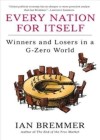Every Nation For Itself: Winners and Losers in a G-Zero World
Written by: Ian Bremmer,
Portfolio Penguin, 2012,
ISBN 9780670921058, 217pp
Reviewed by: Ben Moles
In Every Nation For Itself: Winners and Losers in a G-Zero World Ian Bremmer, President and founder of the political risk research and consultancy firm Eurasia Group, offers an insightful overview and useful guide for the general reader and armchair enthusiast of international affairs as to what he perceives as the fundamental challenge to the extant international system and explores the implications of this in an uncertain future — a G-Zero World.
Bremmer’s thesis paints a rather bleak realist portrait of an anarchic global environment and international system that, over the next decade and perhaps slightly beyond, will be characterised by a deficit in (US) global leadership, a lack of cooperation between states and institutional paralysis within major global institutions in a world. At the same time, there will be a shift in the nature of threats likely to face states, and the emergence of predominantly non-traditional security challenges that, like globalisation, will transcend international borders. In essence, this is the world of the international relations realist — this is every nation for itself.
Bremmer predicts that the problems inherent within the uncertain transformations of the current international system — with an absence of (US) leadership being paramount and the inability to cooperate being secondary — are likely to have a greater impact on the severity, magnitude and effects originating from these emerging non-traditional security challenges. In stark contrast to the stability of the post-World War II US-led Western liberal international world order we have known to this point, he contends that this will be a G-Zero World in a state of ‘tumultuous change’. Yet, what will inevitably be viewed as risks by some countries, companies and organisations will present opportunities for others; ultimately, choice, he asserts, is the key that will separate the winners and losers.
Every Nation For Itself is structured in six chapters and follows a progressive line of argument commencing with an explanation of Bremmer’s concept of the G-Zero. The second chapter presents a slightly long winded history of how we arrived at the G-Zero beginning at the end of World War II. The third assesses the impact of the G-Zero on a diverse set of issues ranging from the global market and interstate/intrastate conflict to climate change and natural resource security before progressing to the fourth, highlighting what this will mean and how this will determine the winners and losers in a G-Zero World. For this reader, the most interesting chapter is the fifth, which asks ‘What comes Next?’ The chapter then proposes, examines and evaluates four ‘likely’ plus one ‘wild card’ future scenarios that will stem from it, concluding that a fragmented ‘world of regions’ is most likely. The sixth and final chapter, ‘G-Zero America’, is unquestionably aimed at the intended target audience of this book — those in the US, in particular those walking the corridors of power, and a wider ‘Western’ audience more generally.
The message of this book is quite clear. Almost drawing a direct parallel to the choice the US was left facing at the end of World War II between ‘retreating into isolationism or expanding its power abroad’, Bremmer subtly alludes to the point that, yet again the US stands at a crossroad but, ‘Invictus’-style, reassures the reader that the US is master of its fate that, to quote Thomas Paine, ‘We [the US] have it in our power to begin the world over again.’
As enjoyable a read as Every Nation For Itself is, there are a few criticisms worthy of mention. First: Bremmer adopts a slightly romanticised, or at least extremely US-centric view concerning both the success and benevolence of US global leadership/stewardship and the achievements of international institutions/ cooperation, neither of which particularly detracts from the quality of the analysis overall.
Nevertheless, following this point is a subsequent criticism. Because of the US- centric view he adopts, the main premise of the argument seems to be that, at the heart of the problem (an inability to cooperate in the face of emerging non- traditional security challenges) is a deficit in (US) leadership and that therein can lie its solution. However, this argument could very easily be turned on its head: the key change is not necessarily a decline in (US) leadership exacerbating these challenges, but the very different nature of these emerging non-traditional security challenges themselves (within a globalised environment), impacting on and leaving the concept of (US) leadership moribund.
Finally, the main criticism: in his introduction to the book, Bremmer qualifies ‘This book is not about the decline of the West. America and Europe have overcome adversity before … Nor is this book about the rise of China and other emerging- market players.’ However, as the book progresses, this theme slowly but surely emanates from the pages so obviously that it makes the reader question the inclusion of the statement to the contrary at all to begin with. Despite protestations otherwise, this book is, in fact, thematically addressing the question surrounding the decline of the US and the rise of China.
Every Nation For Itself is an easy read and the argument is coherent, straightforward and simple to follow; this is certainly not a book furnished with scholarly terminology in which a degree in international relations or economics is a necessary prerequisite. In recommending this book, I would add that, in supplement and complementary to it, those who have had their interest whetted by the themes Bremmer explores but are left wanting more should also refer to the US National Intelligence Council’s recent publication ‘Global Worlds 2030: Alternative Worlds’.

